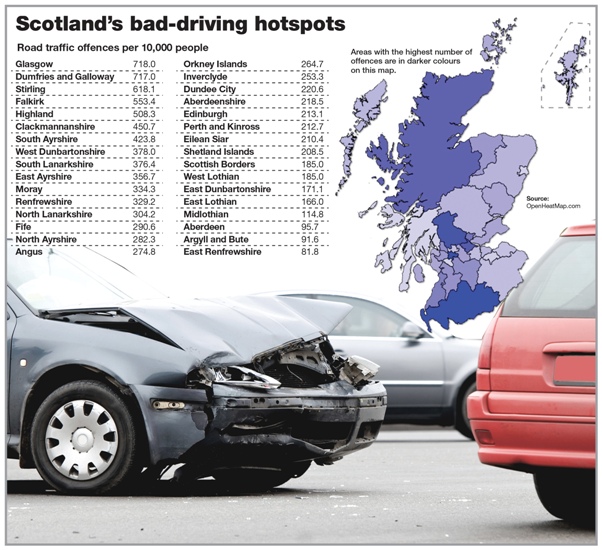
It is the city with the lowest level of car ownership in Scotland - but the country's most traffic offences.
Glasgow last year once again headed a national league table of bad driving, with 46,000 motorists found to flouting the rules of the road in 2014-15.
The figure was the highest in Scotland in both absolute and relative terms.
But traffic insiders stress this reflected the city's location at the heart of Scotland's road network - with numerous out-of-towners on city streets - rather than the quality of local driving.
That is because statistics reveal where bad drivers are caught, not where they are from.
Glasgow had 718 road traffic offences for every 10,000 people last year, pipping Dumfries and Galloway, famous for its get-tough attitude to road offending, where the figure was 717, according to Police Scotland.
But this number means that, in relative terms, nine times more people are caught breaking rules of the road than in neighbouring and leafy East Renfrewshire. And Glasgow's figure was three and a half times bigger, per capita, than in Edinburgh.
A heat map of bad driving: areas with the most traffic offences per 10,000 are darker, those with the least are lighter. Hover over your council area for more information.
Other areas with high per capita traffic offending are Stirling and Falkirk - victims, say those familiar with the figures, of their location in Scotland's transport "cockpit".
Figures for traffic offending do not correlate with those for road fatalities. Glasgow had the highest levels of offending and the second highest figure for deaths, 18. This figure, however, was a spike out of kilter with those for previous years, in part thanks to the December 2014 George Square bin lorry tragedy. Fully a third of those who died did so in this single incident.
In relative terms, Glasgow fared better. Rural roads tend to suffer the worst fatal collisions: Aberdeenshire topped the number of deaths on Scotland's roads at 28 - a 33 per cent increase on the previous year.
Yet recorded traffic offences in Aberdeenshire are relatively low, 218 per 10,000 residents, compared to 717 in broadly comparable Dumfries and Galloway.
The south-western region, which had its own police force until the national merger, has historically prioritised bad driving.
Dumfries and Galloway has also suffered serious fatal road crashes and, although it has a low population, is home to major trunk roads to and from the ferry port of Stranraer and the English frontier.
Nationwide road deaths now account for nearly four times as many fatalities as homicides - although police are taking some comfort from a decline in collisions that result in serious injury.

Glasgow statistics show there still real bad habits in the city.
Glasgow topped the list for drivers being recorded using their mobile phones while driving and for not wearing seatbelts in the last year.
In the financial year, police recorded 5,275 mobile phone related driving offences in the city - a rate of 88.6 offences per 10,000 head of population - making it the highest both in terms of numbers and proportionally.
Drivers in Glasgow are also more likely to be recorded not wearing seatbelts than anywhere else.
Police recorded 4,292 offences involving drivers or their passengers not wearing seatbelts again giving it the highest rate in the country - 72.1 per every 10,000 head of population.
Midlothian is ranked bottom in both seatbelt and mobile phone categories.
Despite being the highest in the country the numbers of mobile phone and seatbelt related offences in Glasgow have in fact dropped dramatically in the last year - mobile phone offences fell by 49 per cent and seatbelt offences dropped by 57 per cent on the previous year.
Police sources said a crackdown in the first year of the national force may have had an impact on such offending.


Why are you making commenting on The Herald only available to subscribers?
It should have been a safe space for informed debate, somewhere for readers to discuss issues around the biggest stories of the day, but all too often the below the line comments on most websites have become bogged down by off-topic discussions and abuse.
heraldscotland.com is tackling this problem by allowing only subscribers to comment.
We are doing this to improve the experience for our loyal readers and we believe it will reduce the ability of trolls and troublemakers, who occasionally find their way onto our site, to abuse our journalists and readers. We also hope it will help the comments section fulfil its promise as a part of Scotland's conversation with itself.
We are lucky at The Herald. We are read by an informed, educated readership who can add their knowledge and insights to our stories.
That is invaluable.
We are making the subscriber-only change to support our valued readers, who tell us they don't want the site cluttered up with irrelevant comments, untruths and abuse.
In the past, the journalist’s job was to collect and distribute information to the audience. Technology means that readers can shape a discussion. We look forward to hearing from you on heraldscotland.com
Comments & Moderation
Readers’ comments: You are personally liable for the content of any comments you upload to this website, so please act responsibly. We do not pre-moderate or monitor readers’ comments appearing on our websites, but we do post-moderate in response to complaints we receive or otherwise when a potential problem comes to our attention. You can make a complaint by using the ‘report this post’ link . We may then apply our discretion under the user terms to amend or delete comments.
Post moderation is undertaken full-time 9am-6pm on weekdays, and on a part-time basis outwith those hours.
Read the rules hereComments are closed on this article